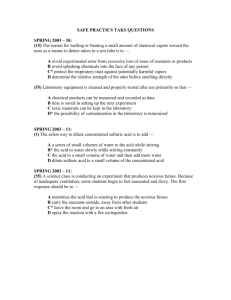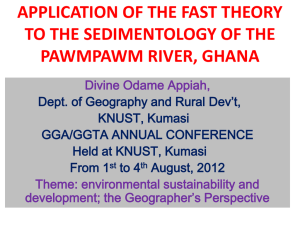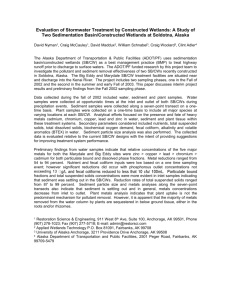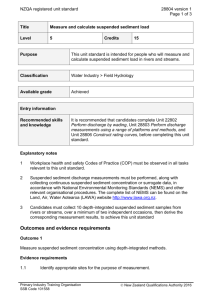Predicting Suspended sediment rating curves Murray Hicks , Dong
advertisement
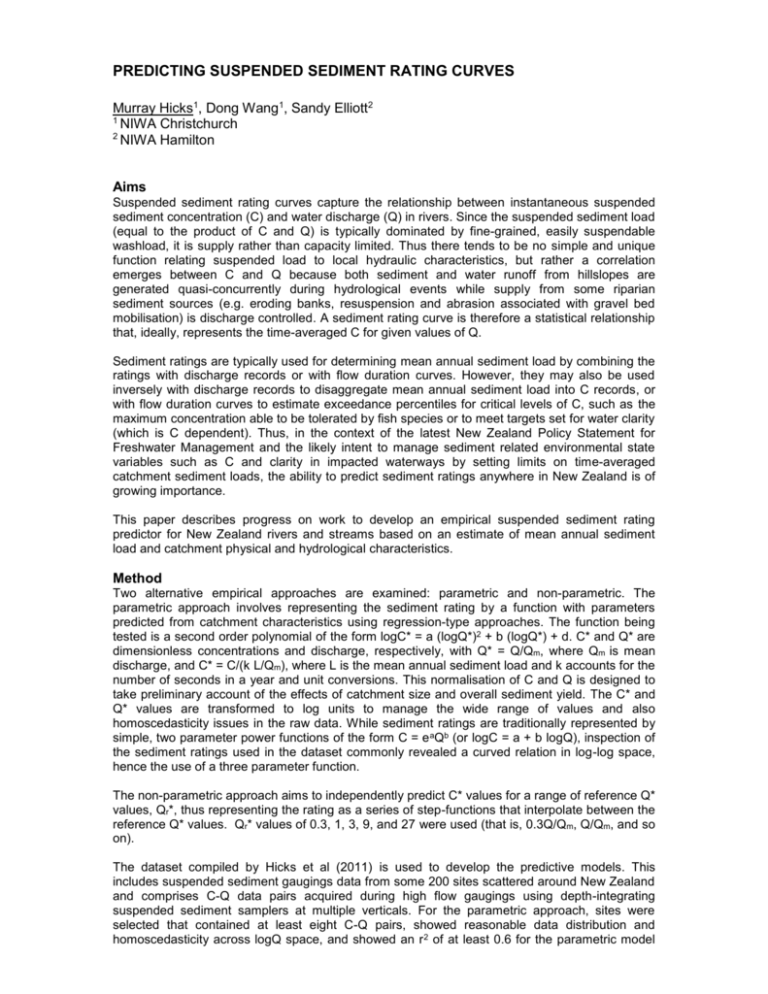
PREDICTING SUSPENDED SEDIMENT RATING CURVES Murray Hicks1, Dong Wang1, Sandy Elliott2 1 NIWA Christchurch 2 NIWA Hamilton Aims Suspended sediment rating curves capture the relationship between instantaneous suspended sediment concentration (C) and water discharge (Q) in rivers. Since the suspended sediment load (equal to the product of C and Q) is typically dominated by fine-grained, easily suspendable washload, it is supply rather than capacity limited. Thus there tends to be no simple and unique function relating suspended load to local hydraulic characteristics, but rather a correlation emerges between C and Q because both sediment and water runoff from hillslopes are generated quasi-concurrently during hydrological events while supply from some riparian sediment sources (e.g. eroding banks, resuspension and abrasion associated with gravel bed mobilisation) is discharge controlled. A sediment rating curve is therefore a statistical relationship that, ideally, represents the time-averaged C for given values of Q. Sediment ratings are typically used for determining mean annual sediment load by combining the ratings with discharge records or with flow duration curves. However, they may also be used inversely with discharge records to disaggregate mean annual sediment load into C records, or with flow duration curves to estimate exceedance percentiles for critical levels of C, such as the maximum concentration able to be tolerated by fish species or to meet targets set for water clarity (which is C dependent). Thus, in the context of the latest New Zealand Policy Statement for Freshwater Management and the likely intent to manage sediment related environmental state variables such as C and clarity in impacted waterways by setting limits on time-averaged catchment sediment loads, the ability to predict sediment ratings anywhere in New Zealand is of growing importance. This paper describes progress on work to develop an empirical suspended sediment rating predictor for New Zealand rivers and streams based on an estimate of mean annual sediment load and catchment physical and hydrological characteristics. Method Two alternative empirical approaches are examined: parametric and non-parametric. The parametric approach involves representing the sediment rating by a function with parameters predicted from catchment characteristics using regression-type approaches. The function being tested is a second order polynomial of the form logC* = a (logQ*)2 + b (logQ*) + d. C* and Q* are dimensionless concentrations and discharge, respectively, with Q* = Q/Qm, where Qm is mean discharge, and C* = C/(k L/Qm), where L is the mean annual sediment load and k accounts for the number of seconds in a year and unit conversions. This normalisation of C and Q is designed to take preliminary account of the effects of catchment size and overall sediment yield. The C* and Q* values are transformed to log units to manage the wide range of values and also homoscedasticity issues in the raw data. While sediment ratings are traditionally represented by simple, two parameter power functions of the form C = e aQb (or logC = a + b logQ), inspection of the sediment ratings used in the dataset commonly revealed a curved relation in log-log space, hence the use of a three parameter function. The non-parametric approach aims to independently predict C* values for a range of reference Q* values, Qr*, thus representing the rating as a series of step-functions that interpolate between the reference Q* values. Qr* values of 0.3, 1, 3, 9, and 27 were used (that is, 0.3Q/Qm, Q/Qm, and so on). The dataset compiled by Hicks et al (2011) is used to develop the predictive models. This includes suspended sediment gaugings data from some 200 sites scattered around New Zealand and comprises C-Q data pairs acquired during high flow gaugings using depth-integrating suspended sediment samplers at multiple verticals. For the parametric approach, sites were selected that contained at least eight C-Q pairs, showed reasonable data distribution and homoscedasticity across logQ space, and showed an r 2 of at least 0.6 for the parametric model fits. The a, b, and d parameters were fitted to each site’s data using non-linear regression techniques within the ‘R’ environment. These parameters were then related to catchment variables using a boosted regression tree approach. For the non-parametric approach, the Cr* values associated with the five Qr* reference values were interpolated from existing sediment rating curves developed at each site in the dataset by Hicks et al (2011), generally using Locally Weighted Scatterplot Smoothing (LOWESS) fits to the log-transformed C and Q data. The Cr* values were then related to catchment characteristics, again using the boosted regression tree approach. Catchment characteristics included catchment area, slope, sediment yield, mean annual rainfall, mean annual runoff, mean annual flood, and a variety of other parameters extracted from the database associated with the national river network developed for the River Environment Classification (REC; Snelder and Biggs, 2002). The boosted regression tree approach requires that predictions must be made within the model development environment, rather than by an explicit function. Thus to transfer the results nationally, the intent is to pre-calculate the sediment rating parameters and/or Cr* values and add them as fields to the REC database. Preliminary Results Preliminary results of the boosted regression tree analysis for the non-parametric approach showed generally good performance statistics, with r2 (indicating proportion of variance in the dataset explained by the model) ranging from 0.88 to 0.96, the root-mean-square error (in log space) ranging from 0.30 to 0.68 (equating to factorial errors of 1.35 to 1.97 in predicted concentration), and Nash–Sutcliffe efficiency (NSE) coefficients ranging from 0.86 to 0.96 (where a NSE value of 1 indicates a perfect model prediction). References Hicks D.M., Shankar U., McKerchar, A., Basher, L., Lynn I., & Jessen, M., 2011. Sediment yield from New Zealand rivers. Journal of Hydrology (NZ) 50, 81-142. Snelder, T.H. & Biggs, B.J.F., 2002. Multi-scale river environment classification for water resources management. Journal of the American Water Resources Association 38, 1225–1240.




